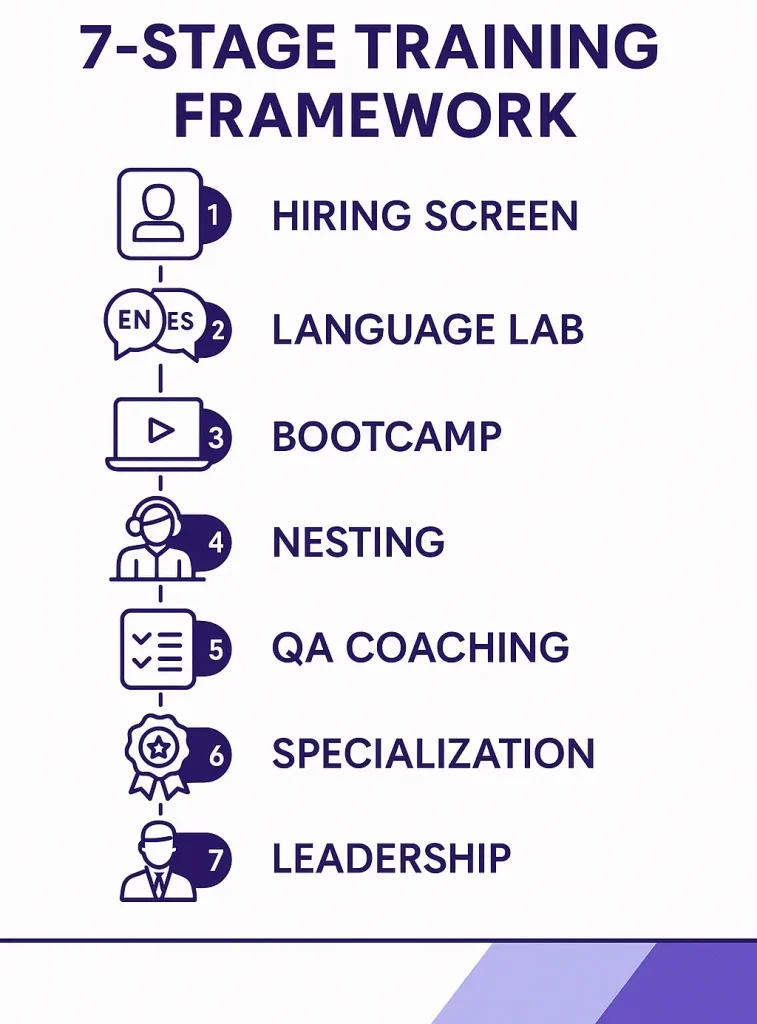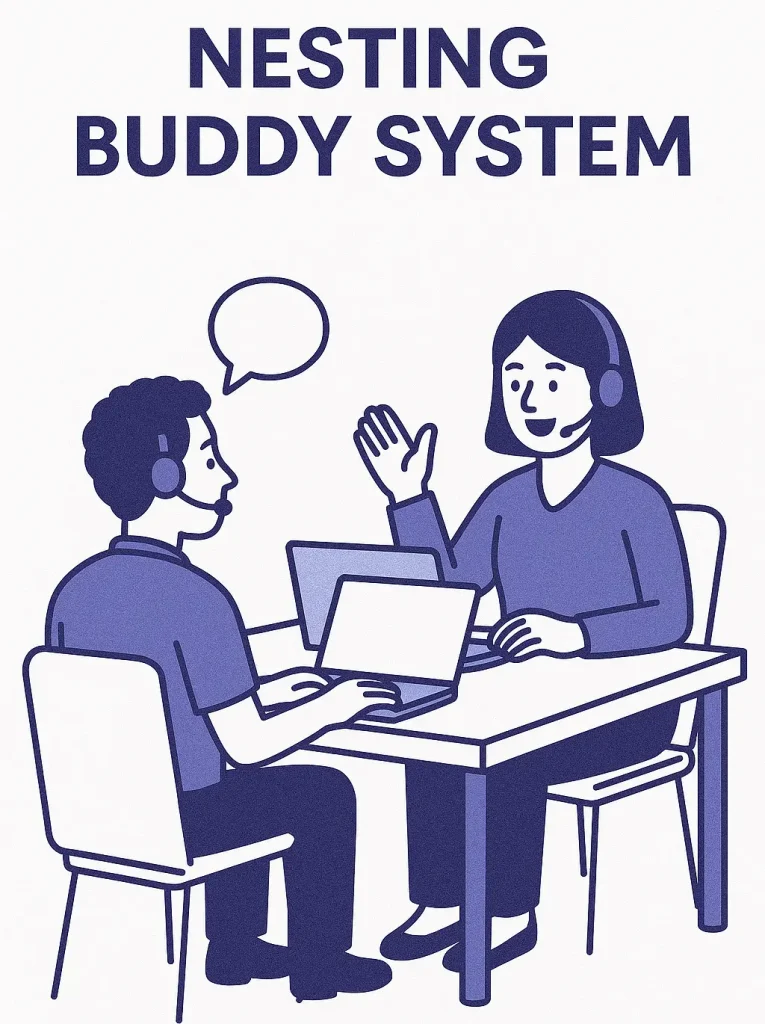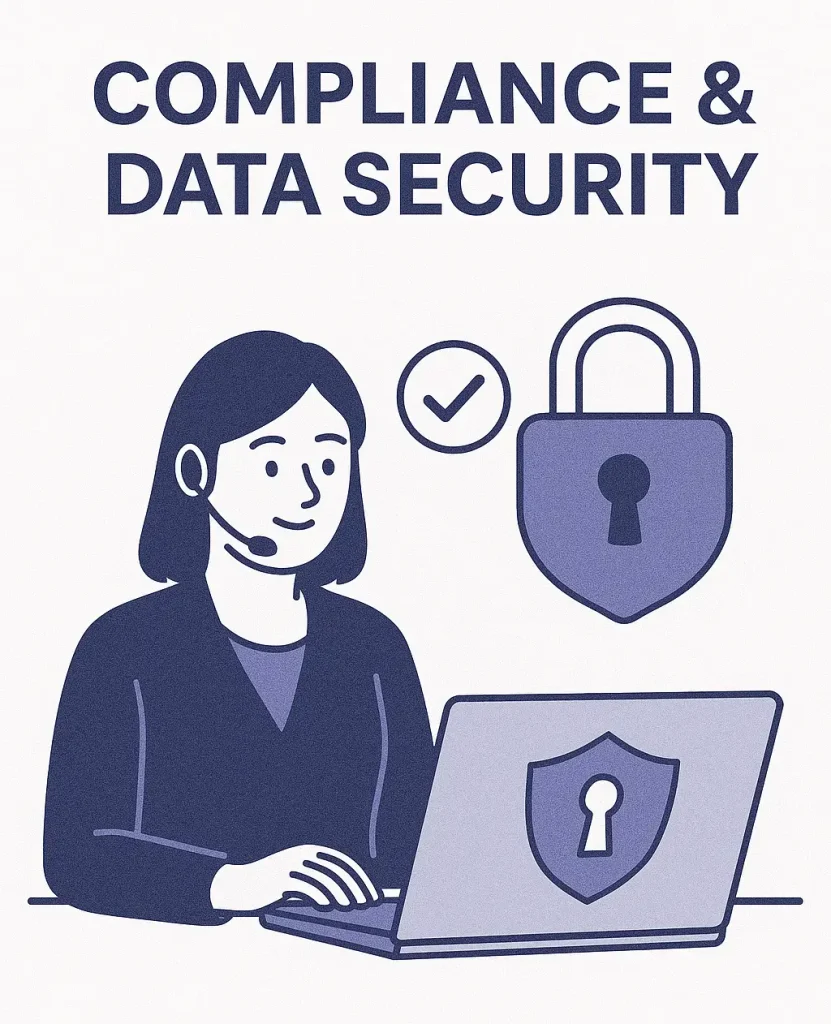How CallZent Trains Bilingual Agents: The Step-by-Step Framework We Actually Use
Published: August 21, 2025 — Nearshoring Call Center Services
TL;DR — What You’ll Learn in 90 Seconds
- Talent first: We recruit for bilingual clarity, coachability, and customer empathy—not just “years of experience.”
- Language labs + roleplays: Agents start with baselines (inspired by ACTFL/CEFR) and train through live drills, writing samples, and listening comprehension.
- Nesting done right: Supervised go-live with “buddy” support, double-scoring, and rapid feedback loops.
- Quality that scales: Weekly calibrations, targeted micro-coaching, and QA rubrics tied to
CSAT,FCR,AHT, andCompliance. - Security by design: Training uses masked data and least-privilege access; we align with SOC 2-style controls and client standards like PCI/HIPAA where required.
- Continuous improvement: Agent-specific learning paths, domain certifications, and leadership tracks lower churn and lift performance.
Why Bilingual Training Matters (More Than You Think)
If you want loyal customers, language isn’t a checkbox; it’s the connective tissue of trust. Bilingual support fails when it’s treated as “English + Spanish words” instead of understanding + clarity + cultural fit. Great bilingual agents do four things relentlessly well: they listen actively, remove ambiguity, confirm understanding, and close the loop quickly—without sounding scripted.
That’s why our training program doesn’t just chase perfect grammar; it targets the behaviors that move customer outcomes. If a technique doesn’t lift retention and CSAT, we don’t do it. Period.
Related reads:
Our Training Philosophy: Clarity, Confidence, Consistency
Customers don’t reward perfect accents; they reward clarity and confidence. Our coaching is designed to remove friction—hesitation, unclear handoffs, weak probing, and “answering the wrong question.” We build habits that make conversations simpler, faster, and more human. We’re direct about what works and what doesn’t. If a behavior doesn’t serve the customer, it gets coached out.
- Clarity: pace, structure, and confirmation loops so customers never wonder what’s next.
- Confidence: roleplay, objection handling, and tool fluency to reduce dead air and transfers.
- Consistency: QA rubrics to keep good behaviors sticky across teams and shifts.
It’s not sexy, but it’s the difference between “polite but ineffective” and problem solved.
The 7-Stage Training Framework We Use at CallZent
0) Hiring Profile & Screening (Before Day 1)
We select for bilingual clarity (not just vocabulary), coachability, and service mindset. Screenings include:
- Live bilingual screen: English/Spanish conversation with topic shifts, paraphrasing, and confirmation.
- Recorded read-back: Measures pronunciation, cadence, and punctuation awareness.
- Writing sample: Email/chat response with tone, formatting, and grammar checks.
- Role fit: We map candidates to campaigns (customer care, sales/lead gen, tech support) based on strengths.
1) Baseline & Language Labs (Week 1)
Agents start with baseline assessments against recognized frameworks inspired by ACTFL and CEFR. We test listening, speaking, writing, and scenario navigation. Labs target:
- Clarity drills: pacing, chunking, enunciation, and echoing.
- Listening for intent: catching implied meaning, not just literal words.
- Micro-grammar: prepositions, articles, and connectors that shape meaning.
- Writing polish: greetings, formatting, and signature standards for email/chat.
2) Campaign Bootcamp (Days 3–7)
Bootcamp fuses language with domain knowledge. We co-build playbooks with clients to accelerate context acquisition:
- Product/service deep dive: benefits, policies, top reasons for contact, edge cases.
- Glossaries: bilingual terminology and common customer idioms to avoid misunderstandings.
- Scenario bank: 30–50 “greatest hits” situations plus variant twists (angry, urgent, confused, silent).
- “Say/Do/Show” scripting: flexible prompts that leave room for natural conversation.
- System navigation drills: clicks and keystrokes, not just theory—because speed = confidence.
Pro tip: If you’re comparing vendors, ask to see a real scenario bank and a sample QA rubric. Then request a 20-minute calibration session. You’ll know in 5 minutes whether the program is serious.
3) Shadowing & Nesting (Weeks 2–3)
After bootcamp, agents enter supervised production. Two guardrails keep quality high:
- Buddy system: new agents sit with a seasoned “buddy” for live side-by-sides and quick answers.
- Double-scoring: QA evaluates early contacts twice—once for language clarity and again for process adherence.
We use tight feedback loops: 10–15 minutes post-block to highlight 2–3 wins and 1 behavior to fix immediately. Nothing gets lost in weekly summaries; we coach same day.
4) QA Coaching & Micro-Learning (Ongoing)
Every QA score must translate into a behavior change. We assign short, targeted learning bites:
- “Watch & mirror” clips: 30–90 second examples of excellent phrasing or call control.
- Guided replays: agents review their own calls, mark improvement points, and rewrite lines.
- Weekly calibrations: QA, supervisors, and client SMEs align on what “good” sounds like.
5) Specialization Tracks (Weeks 3–6)
As agents stabilize, they branch into specializations:
- Customer care: de-escalation, empathy, and first-contact resolution.
- Sales/lead gen: discovery, objection handling, and next-step closing.
- Tech support: step sequencing, summaries, and device/course-correct language.
- Verticals: insurance, legal intake, retail/e-commerce, and SaaS.
6) Leadership & Peer Coaching (Months 2–4)
We identify high performers early and train them to coach peers. It reduces knowledge bottlenecks and improves retention. Leaders learn to run calibrations, spot-check QA, and lead 1:1s with measurable outcomes.
Communication Skills That Create Fans (Not Just “Handled Tickets”)
Language proficiency is necessary; communication mastery wins loyalty. These are the core disciplines we drill:
Accent Clarity (Not Erasure)
Customers don’t need “zero accent.” They need clarity. We coach pace, breathing, enunciation, and prosody (stress and intonation) so meaning lands on the first pass.
Code-Switching with Purpose
Great bilingual agents switch languages—and registers—intentionally. We teach when to mirror the customer’s language, when to confirm in both languages, and how to switch without signaling confusion.
Structure, Summaries, and Sign-Offs
Every conversation gets a beginning, middle, and end. We train agents to set the agenda, confirm what was done, and list clear next steps. Written channels use formatting standards that make scanning effortless.
Empathy & De-Escalation
Empathy is a behavior, not a personality trait. Agents learn to validate feelings, anchor on shared goals, and make specific commitments (“Here’s what I’ll do in the next 3 minutes”).
Want more on this? See Agent Retention and the Value of Stability and Nearshore vs Offshore for the bigger picture.
Quality Assurance That Actually Changes Behavior
QA isn’t paperwork; it’s a performance engine. Ours includes:
- Behavior-based rubrics: We grade what the customer feels (clarity, confidence, care) and what the business needs (accuracy, security, resolution).
- Calibration rhythm: Weekly cross-functional reviews keep definitions tight and fair.
- Targeted coaching plans: QA scorecards are tied to micro-learnings agents can complete in 5–10 minutes.
- Closed loop: Supervisors verify that one coached behavior shows up on the next 3–5 monitored contacts.
We align to industry guidance (e.g., COPC best practices) while tailoring to the realities of your campaign.
Compliance, Security, and Data Handling (By Design)
Training never trumps security. We align our controls with SOC 2-style principles and, where applicable, client frameworks like PCI DSS and HIPAA. During training and nesting:
- Masked data environments: real workflows using anonymized or dummy records.
- Least-privilege access: new agents only see what they need to complete their task.
- Auditability: activity logging and restricted recordings per client policy.
- Process rehearsal: break-glass scenarios (fraud cues, privacy requests, escalations) are practiced before production.
For a deeper dive on our posture, see Security & Compliance in MX BPOs.
Metrics That Matter (and the Traps We Avoid)
KPIs without behavior mapping are vanity. Ours aren’t:
- Quality: QA score (by behavior), compliance adherence, knowledge accuracy.
- Customer: CSAT, FCR, complaint rate, recontact rate.
- Efficiency: AHT, handle variance, occupancy, schedule adherence.
- Sales (if applicable): conversion rate, opportunity creation, revenue per hour.
- Team health: ESAT, coaching completion, tenure distribution.
Traps we avoid: obsessing over AHT at the expense of FCR, rewarding speed over accuracy, and grading language “polish” instead of clarity. Customers want results, not speed runs.
The Nearshore Edge: Why Tijuana Produces Elite Bilingual Teams
Proximity matters. Our teams work on U.S. time zones, share cultural context, and live bilingual lives—media, music, slang, and day-to-day interactions. That translates into fewer misunderstandings and faster rapport.
If you’re exploring partners, read Best Bilingual Support Centers in Tijuana, plus How to Choose the Best Call Center in Mexico for a buyer’s checklist.
Pilot Timeline: What You Can Expect
Week 0: Prep
- Role definition, call drivers, and success metrics.
- Playbook co-build: scenarios, glossary, policies.
- Access, environment, and data masking confirmed.
Week 1: Baseline + Bootcamp
- Language labs and campaign deep dive.
- System drills, scenario roleplays, and dry runs.
- Client calibration on “what good sounds like.”
Weeks 2–3: Nesting
- Supervised production with buddy support.
- Double-scoring and same-day micro-coaching.
- Daily huddles with client for quick adjustments.
Week 4+: Scale
- Full production, specialization tracks.
- Weekly calibrations, monthly business reviews.
- Refine playbook; expand seats with confidence.
Want a 2–3 week pilot? We’ll co-build your bilingual playbook, run a measured nesting phase, and prove outcomes before you scale. Start here or explore our Sales & Lead Gen capabilities.
Mini Case Snapshots (Anonymized)
01) E-Commerce CX — English/Spanish Chat + Email
- Problem: repeated recontacts; unclear returns language.
- Fix: bilingual templates with plain-language summaries; roleplays for refund edge cases.
- Outcome: recontact rate down; CSAT up; AHT stable due to clearer guidance.
02) Insurance Intake — Voice
- Problem: long discovery; customers repeating information.
- Fix: roadmap openings, confirmation loops, and data capture phrasing that avoids double-asking.
- Outcome: faster first-stage approvals; fewer escalations.
03) SaaS Onboarding — Bilingual Email + Screen-Share
- Problem: support sounded “technical,” not helpful.
- Fix: teach “say/do/show” with micro-videos and checklists; writing standards for scannable steps.
- Outcome: activation rate improved; onboarding time reduced.
EEAT: Experience, Expertise, Authority, Trust
About the Author
Joe Andere is the CEO of CallZent, a U.S.-owned & nearshore-operated contact center based in Tijuana, Mexico. He’s led bilingual CX, sales, and research programs across multiple industries and is obsessed with the craft of clear, human communication.
References & Useful Frameworks
FAQs
How long does it take a new bilingual agent at CallZent to be production-ready?
Typical path: 1–2 weeks for bootcamp + nesting, then full production by weeks 3–4 for standard programs. Highly technical or regulated programs may take longer. Speed is never prioritized over accuracy and clarity.
Do you hire for native English only?
No. We hire for bilingual clarity and effectiveness: the ability to understand, diagnose, and resolve in either language. Native-level fluency is great; clear, confident communication is essential.
How do you assess bilingual proficiency?
Live roleplays, recorded read-backs, scenario testing, and writing samples benchmarked against ACTFL/CEFR-inspired criteria for listening, speaking, writing, and comprehension.
What tools do you use for training?
A mix of live drills, scenario banks, QA scorecards, and agent micro-learnings. For client environments, we train in approved systems using masked data and least-privilege access.
Do you offer accent training?
We coach for accent clarity—pacing, enunciation, and prosody—so customers understand on the first pass. We do not “erase” accents; we make communication effortless.
How do you prevent quality drops when scaling?
We keep calibration frequent, double-score early contacts, and pair new classes with buddies. Leaders are trained to coach, not just supervise, so habits stick under load.
Can you support specialized industries like insurance or legal intake?
Yes. We build domain playbooks, bilingual glossaries, and scenario archives. See our Smart Sourcing and Nearshoring Services pages for examples.
How do you measure agent progress after initial training?
Through QA trend lines by behavior, CSAT/FCR changes, coaching completion, and performance on scenario refreshers. We expect improved clarity markers in the next 3–5 monitored contacts after coaching.
Do you handle Spanish-first customer bases?
Absolutely. We support Spanish-first audiences across LATAM and U.S. Spanish speakers. See Bilingual Talent in Mexico and Spanish Support by Region.
What’s the best way to start with CallZent?
A scoped pilot. We define goals, build the playbook, and prove outcomes in 2–3 weeks before scaling. Get started.
<!













